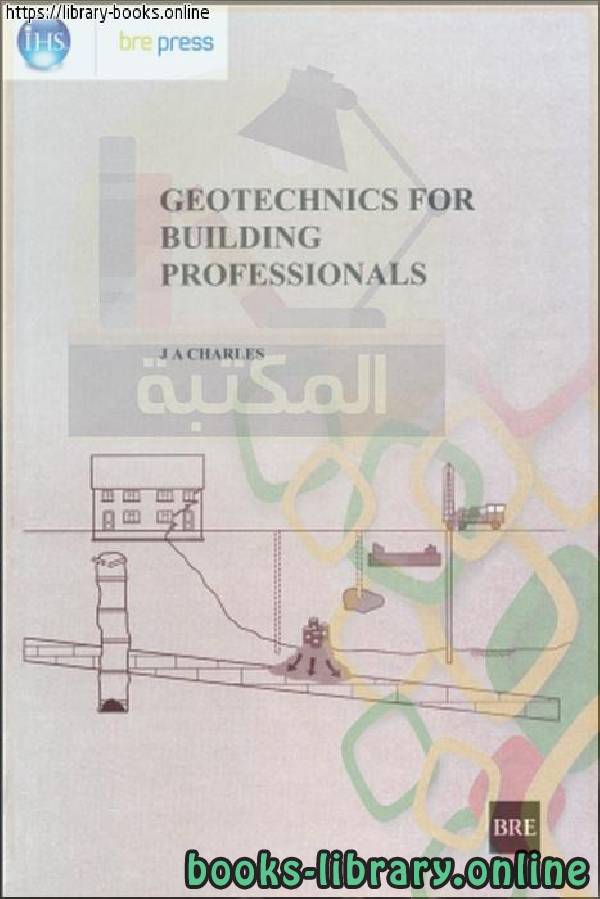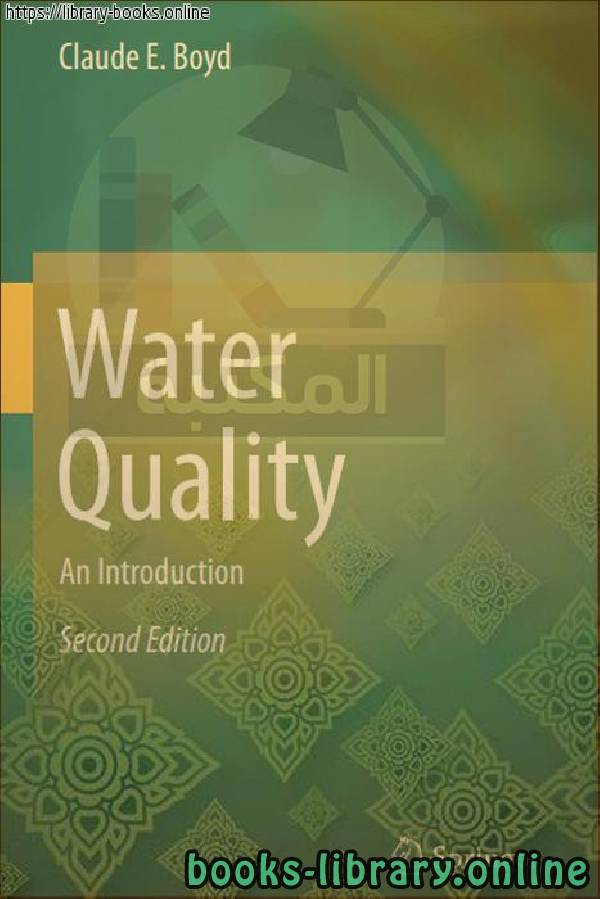كتاب Building Research Establishment-Geotechnics for building professionals
نبذه عن الكتاب: FOREWORD Having been Head of the Geotechnics Division at the Building Research Station from 1972 to 1980, it is a particular pleasure for me to be invited to write this foreword. Written for the nonspecialist, this book is a distillation of the large reservoir of expertise, experience and guidance on foundations for low-rise buildings which has accumulated at BRE over many years. This experience is based on research into the actual behaviour of buildings founded on a wide range of difficult ground conditions, studies of the effectiveness of various ground treatment methods and detailed examinations of the causes and severity of damage in hundreds of buildings. For many, indeed most, building professionals and structural engineers, geotechnics is something of a black art. The ground is mysterious: every trench, hole and excavation opened up is a journey into an uncharted underworld. When problems with foundations occur, rumours abound – underground streams, old wells, hidden cavities, previous uses of the site and so on. On one occasion, I visited the site of a foundation excavation in Salisbury, the bottom of which had turned into a soft slurry owing to upward seepage of water, and was told by an engineer that the whole of Salisbury was floating on liquid chalk! Why is it that geotechnics comes across as a mysterious and inaccessible subject? For most building materials, such as steel, cement, concrete and brickwork, the stiffness and strength can be specified and remain reasonably fixed and dependable. For soils, however, the stiffness and strength depends on the stress acting on them and the water pressures acting within them, and these can change significantly during and after construction. In most cases, the professional cannot specify the founding material but has to work with what nature has provided; and nature is seldom straightforward. To understand the methodology of the geotechnical engineer, it is helpful to compare it with the approach adopted by a structural engineer or building professional working on an ancient building. A detailed inspection is essential to discover what materials were used and how the building was constructed. Special attention is given to detecting signs of weakness and defects since these can dominate behaviour. Historical records can reveal the history of construction and give important clues as to the building’s overall response. This book demonstrates that the geotechnical engineer works in exactly the same way. First, discover what is there: the ground profile and groundwater conditions at the site and how they vary across it. For low-rise buildings, highly sophisticated testing is rarely required; it is usually necessary to know only what the soil types are (fine or coarse material) and how dense they are (density is an indicator of stiffness and strength). Particular emphasis must be placed on identifying previous uses of the site, potential hazards and difficult ground. Much can be learned from local experience and records such as aerial photographs and old maps. Skimping on the investigation can lead to very costly and timeconsuming corrective measures, just as they can for an ancient building. So Chapter 5 Ground assessment is fundamental to the whole book and is a ‘must-read’.كاتب غير معروف - يشمل يركن (كاتب غير معروف) كل الكتب التي لا يعرف مؤلفيها، حيث أن العمل في شيء بالشكل المجهول هو التدخل بشكل شخصي دون استخدام اسم محدد أو التعريف عن الهوية، وتشير حالة "غير معروف" أو "المجهول" عادة إلى حالة شخص ما بدون معرفة عامة لشخصيته أو لمعلومات تحدد هويته. هناك العديد من الأسباب التي يختار من أجلها شخص ما إخفاء شخصيته أو أن يصبح مجهولا. يكون بعض تلك الأسباب قانونيا أو اجتماعيا، مثل إجراء الأعمال الخيرية أو دفع التبرعات بشكل مجهول، حيث يرغب بعض من المتبرعين بعدم الإشارة إلى تبرعاتهم بأي شكل يرتبط بشخصهم. كما أن من يتعرض أو قد يتعرض للتهديد من قبل طرف ما يميل إلى إخفاء هويته، مثل الشهود في محاكمات الجرائم، أو الاتصال بشكل مجهول بالسلطات للإدلاء بمعلومات تفيد مسار التحقيق في القضايا العالقة. كما أن المجرمين بشكل عام يحاولون إبقاء أنفسهم مجهولي الهوية سواء من أجل منع إشهار حقيقة ارتكابهم للجريمة أو لتجنب القبض عليهم.
من Biology Books علم الأحياء - مكتبة الكتب العلمية.

قراءة كتاب Building Research Establishment-Geotechnics for building professionals أونلاين
معلومات عن كتاب Building Research Establishment-Geotechnics for building professionals:
FOREWORD
Having been Head of the Geotechnics Division at the Building
Research Station from 1972 to 1980, it is a particular pleasure
for me to be invited to write this foreword. Written for the nonspecialist, this book is a distillation of the large reservoir of
expertise, experience and guidance on foundations for low-rise
buildings which has accumulated at BRE over many years. This
experience is based on research into the actual behaviour of
buildings founded on a wide range of difficult ground
conditions, studies of the effectiveness of various ground
treatment methods and detailed examinations of the causes and
severity of damage in hundreds of buildings.
For many, indeed most, building professionals and structural
engineers, geotechnics is something of a black art. The ground
is mysterious: every trench, hole and excavation opened up is a journey into an uncharted
underworld. When problems with foundations occur, rumours abound – underground streams, old
wells, hidden cavities, previous uses of the site and so on. On one occasion, I visited the site of a
foundation excavation in Salisbury, the bottom of which had turned into a soft slurry owing to
upward seepage of water, and was told by an engineer that the whole of Salisbury was floating on
liquid chalk!
Why is it that geotechnics comes across as a mysterious and inaccessible subject? For most building
materials, such as steel, cement, concrete and brickwork, the stiffness and strength can be specified
and remain reasonably fixed and dependable. For soils, however, the stiffness and strength depends
on the stress acting on them and the water pressures acting within them, and these can change
significantly during and after construction. In most cases, the professional cannot specify the
founding material but has to work with what nature has provided; and nature is seldom
straightforward.
To understand the methodology of the geotechnical engineer, it is helpful to compare it with the
approach adopted by a structural engineer or building professional working on an ancient building. A
detailed inspection is essential to discover what materials were used and how the building was
constructed. Special attention is given to detecting signs of weakness and defects since these can
dominate behaviour. Historical records can reveal the history of construction and give important clues
as to the building’s overall response.
This book demonstrates that the geotechnical engineer works in exactly the same way. First, discover
what is there: the ground profile and groundwater conditions at the site and how they vary across it.
For low-rise buildings, highly sophisticated testing is rarely required; it is usually necessary to know
only what the soil types are (fine or coarse material) and how dense they are (density is an indicator
of stiffness and strength). Particular emphasis must be placed on identifying previous uses of the site,
potential hazards and difficult ground. Much can be learned from local experience and records such
as aerial photographs and old maps. Skimping on the investigation can lead to very costly and timeconsuming corrective measures, just as they can for an ancient building. So Chapter 5 Ground
assessment is fundamental to the whole book and is a ‘must-read’.
للكاتب/المؤلف : كاتب غير معروف .
دار النشر : BRE Bookshop .
سنة النشر : 2010م / 1431هـ .
عدد مرات التحميل : 4102 مرّة / مرات.
تم اضافته في : الخميس , 30 يناير 2020م.
حجم الكتاب عند التحميل : 3.389 .
تعليقات ومناقشات حول الكتاب:
Biologically
Biology is a natural science that is concerned with the study of life, its various forms and its function, how these organisms interact with each other and with the surrounding environment. The word biology in Greek is made up of two words: bio (βίος) meaning life. And loggia (-λογία) means science or study. Biology: the similarity of vegetation and animal cover on the edges of the African and American states, and the existence of the same fossil.
Branches of biology
Biology is an ancient science thousands of years old and modern biology began in the nineteenth century. This science has multiple branches. Among them are:
Anatomy
Botany
Biochemia
Biogeography
Biofisia
Cytology or cell science
Ecology or environmental science
نبذه عن الكتاب:
FOREWORD
Having been Head of the Geotechnics Division at the Building
Research Station from 1972 to 1980, it is a particular pleasure
for me to be invited to write this foreword. Written for the nonspecialist, this book is a distillation of the large reservoir of
expertise, experience and guidance on foundations for low-rise
buildings which has accumulated at BRE over many years. This
experience is based on research into the actual behaviour of
buildings founded on a wide range of difficult ground
conditions, studies of the effectiveness of various ground
treatment methods and detailed examinations of the causes and
severity of damage in hundreds of buildings.
For many, indeed most, building professionals and structural
engineers, geotechnics is something of a black art. The ground
is mysterious: every trench, hole and excavation opened up is a journey into an uncharted
underworld. When problems with foundations occur, rumours abound – underground streams, old
wells, hidden cavities, previous uses of the site and so on. On one occasion, I visited the site of a
foundation excavation in Salisbury, the bottom of which had turned into a soft slurry owing to
upward seepage of water, and was told by an engineer that the whole of Salisbury was floating on
liquid chalk!
Why is it that geotechnics comes across as a mysterious and inaccessible subject? For most building
materials, such as steel, cement, concrete and brickwork, the stiffness and strength can be specified
and remain reasonably fixed and dependable. For soils, however, the stiffness and strength depends
on the stress acting on them and the water pressures acting within them, and these can change
significantly during and after construction. In most cases, the professional cannot specify the
founding material but has to work with what nature has provided; and nature is seldom
straightforward.
To understand the methodology of the geotechnical engineer, it is helpful to compare it with the
approach adopted by a structural engineer or building professional working on an ancient building. A
detailed inspection is essential to discover what materials were used and how the building was
constructed. Special attention is given to detecting signs of weakness and defects since these can
dominate behaviour. Historical records can reveal the history of construction and give important clues
as to the building’s overall response.
This book demonstrates that the geotechnical engineer works in exactly the same way. First, discover
what is there: the ground profile and groundwater conditions at the site and how they vary across it.
For low-rise buildings, highly sophisticated testing is rarely required; it is usually necessary to know
only what the soil types are (fine or coarse material) and how dense they are (density is an indicator
of stiffness and strength). Particular emphasis must be placed on identifying previous uses of the site,
potential hazards and difficult ground. Much can be learned from local experience and records such
as aerial photographs and old maps. Skimping on the investigation can lead to very costly and timeconsuming corrective measures, just as they can for an ancient building. So Chapter 5 Ground
assessment is fundamental to the whole book and is a ‘must-read’.
Biology
Human biology
Who is the founder of biology?
The importance of biology
Areas of work in the field of biology
Theories of biology
Research on biology for the first grade of secondary school
Human biology
 مهلاً !
مهلاً !قبل تحميل الكتاب .. يجب ان يتوفر لديكم برنامج تشغيل وقراءة ملفات pdf
يمكن تحميلة من هنا 'تحميل البرنامج'

نوع الكتاب : pdf.
اذا اعجبك الكتاب فضلاً اضغط على أعجبني و يمكنك تحميله من هنا:


كتب اخرى في Biology Books
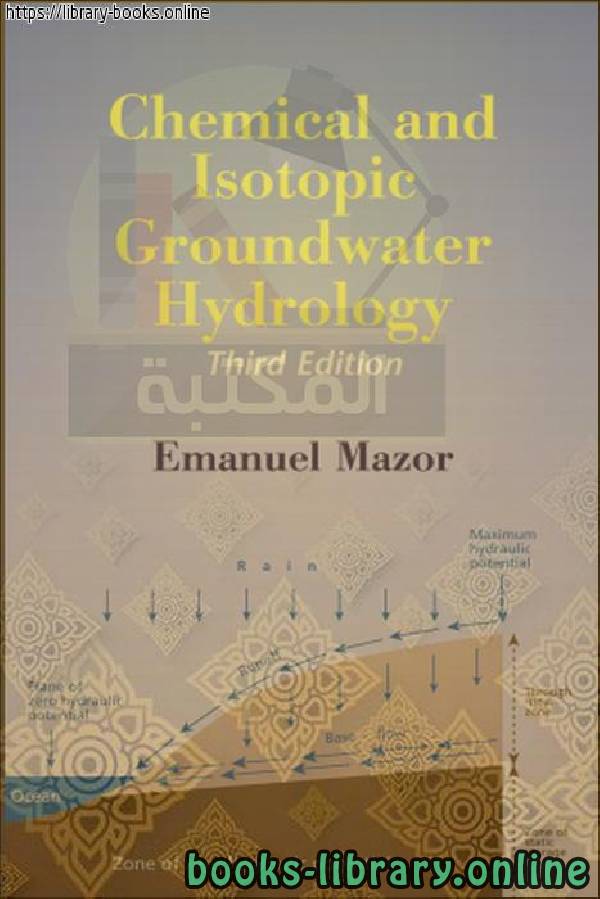
Chemical and Isotopic Groundwater Hydrology PDF
قراءة و تحميل كتاب Chemical and Isotopic Groundwater Hydrology PDF مجانا

Committee on Floodplain Mapping Technologies, National Research Council PDF
قراءة و تحميل كتاب Committee on Floodplain Mapping Technologies, National Research Council PDF مجانا
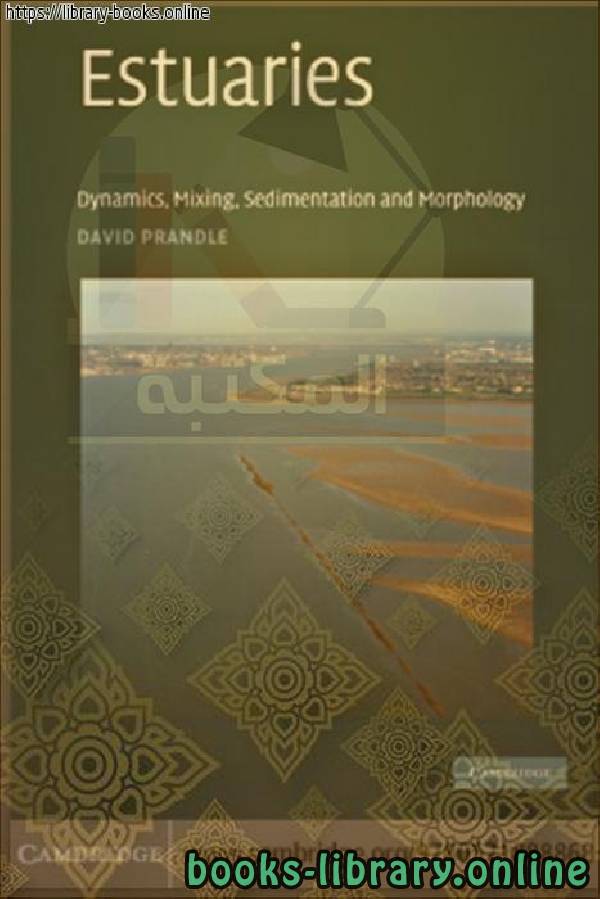
Dynamics, Mixing, Sedimentation and Morphology PDF
قراءة و تحميل كتاب Dynamics, Mixing, Sedimentation and Morphology PDF مجانا
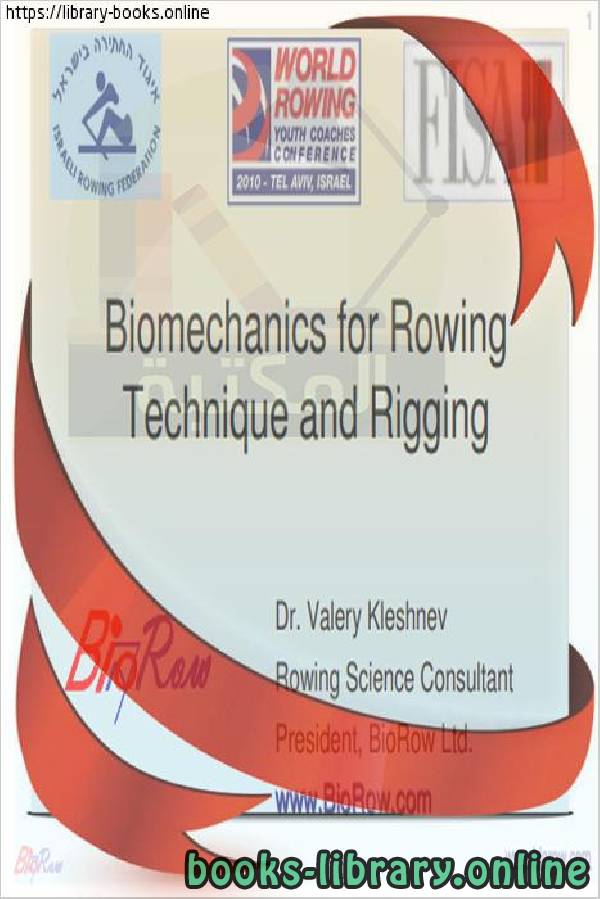
Biomechanics for Rowing technique and rigging PDF
قراءة و تحميل كتاب Biomechanics for Rowing technique and rigging PDF مجانا
